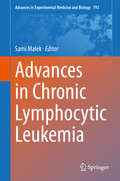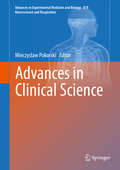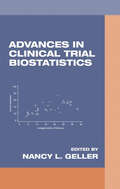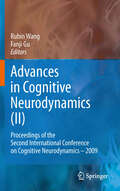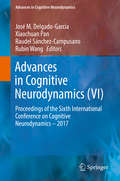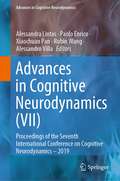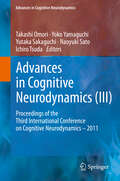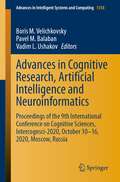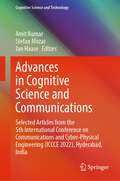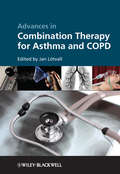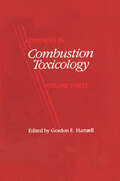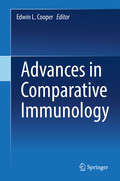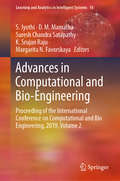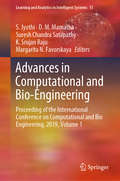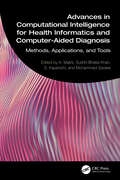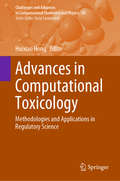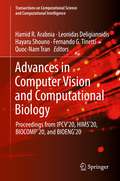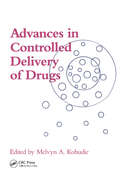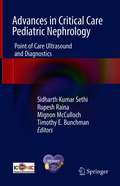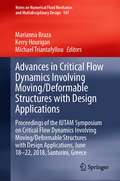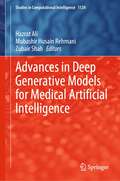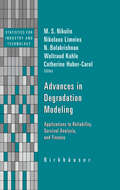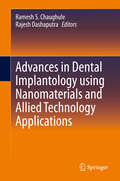- Table View
- List View
Advances in Chronic Lymphocytic Leukemia (Advances in Experimental Medicine and Biology #792)
by Sami MalekChronic lymphocytic leukemia (CLL) is the most common leukemia in the Western world. CLL has a highly varied clinical course. While advances in CLL therapy are noted, many patients still succumb to this illness. Like most progress in medicine, solid advances in the diagnosis, prognosis and treatment of CLL are rooted in an in-depth understanding of the basic and translational biology of CLL. In this book, CLL experts have contributed state-of-the-art summaries of various important aspects of CLL biology and have discussed the translational implication of such findings. This book, which is directed at physicians and researchers alike, aims to educate broadly and deeply. Intentionally, the many aspects and nuances of CLL clinical care that can only really be appreciated through direct patient care are not covered here, but instead, the book presents basic aspects of CLL that underlie many of the contemporary decisions that are made in CLL research and clinical settings. We hope that this book will critically inform the community and stimulate interest in CLL, which will ultimately translate into better CLL research, prognostication and therapy, with the end goal of providing a better outlook for patients afflicted with this common leukemia.
Advances in Clinical Science (Advances in Experimental Medicine and Biology #878)
by Mieczyslaw PokorskiThe book presents the latest developments in clinical medicine, particularly involved with pulmonary care and diseases. Emphasis is placed on the role of childhood obesity, often a result of the ill effects of an unhealthy diet and nutritional deficits, in shaping propensity for inflammatory pathologies, allergies, immune deficiency and respiratory and cardiovascular sequelae in adult life. Oxidative damage, caused by not full well understood cellular biochemistry, when unchecked by antioxidative rescue mechanisms, takes toll on a respiratory health. The book underscores the need to consider the complexity of mutual interactions of pathophysiological processes, which calls for tailoring the management strategies depending on the subgroups which patients belong to, be it obesity, children or elderly. The chapters also tackle biological diseases with genetic underpinnings. The application of genetics to identify the molecular alterations or mutations will serve well both diagnostics and targeted optimization of treatment; the poignant exemplar being the histological subtypes of lung cancer. The book provides a source of current facts and trends in clinical research and practice.
Advances in Clinical Trial Biostatistics (Chapman & Hall/CRC Biostatistics Series #Vol. 13)
by Nancy L. GellerFrom aspects of early trials to complex modeling problems, Advances in Clinical Trial Biostatistics summarizes current methodologies used in the design and analysis of clinical trials. Its chapters, contributed by internationally renowned methodologists experienced in clinical trials, address topics that include Bayesian methods for phase I clinica
Advances in Cognitive Neurodynamics: Proceedings of the Second International Conference on Cognitive Neurodynamics - 2009 (Advances in Cognitive Neurodynamics)
by Fanji Gu Rubin WangWithin our knowledge, the series of the International Conference on Cognitive Neurodynamics (ICCN) is the only conference series dedicating to cognitive neurodynamics. This volume is the proceedings of the 2nd International Conference on Cognitive Neurodynamics held in 2009, which reviews the progress in this field since the 1st ICCN -2007. The topics include: Neural coding and realistic neural network dynamics, Neural population dynamics, Firing Oscillations and Patterns in Neuronal Networks, Brain imaging, EEG, MEG, Sensory and Motor Dynamics, Global cognitive function, Multi-scalar Neurodynamics - from Physiology to Systems Theory, Neural computing, Emerging Technologies for Brain Computer Interfaces, Neural dynamics of brain disorders.
Advances in Cognitive Neurodynamics: Proceedings of the Sixth International Conference on Cognitive Neurodynamics – 2017 (Advances in Cognitive Neurodynamics)
by José M. Delgado-García Xiaochuan Pan Raudel Sánchez-Campusano Rubin WangThis proceedings contains articles submitted to the sixth International Conference on Cognitive Neurodynamics (ICCN2017). The Meeting included plenary lectures, specialized symposia, and posters presentations. The main topics of the meeting addressed the general substrates underlying neural functions and the neural dynamics in sensory, motor, and cognitive systems. Other important neuroscience fields covered in the meeting were learning and memory processes and the functionally-related changes in synaptic strength, neural oscillations, synchronizations and coherence activities between different neural circuits, and the imaging of cognitive networks. Finally, specific articles covered several fields related to neural computation and neuroengineering, the modelling higher-order functions and dysfunctions and the experimental design of brain-to-computer and brain-to-brain interactions. All articles were peer-reviewed. The ICCN is a series conference that takes place every two years since 2007.
Advances in Cognitive Neurodynamics: Proceedings of the Seventh International Conference on Cognitive Neurodynamics – 2019 (Advances in Cognitive Neurodynamics)
by Alessandra Lintas Paolo Enrico Xiaochuan Pan Rubin Wang Alessandro VillaThis book contains original articles submitted to the Seventh International Conference on Cognitive Neurodynamics (ICCN 2019). The brain is an endless case study of a complex system characterized by multiple levels of integration, multiple time scales of activity, and multiple coding and decoding properties. The contribution of several disciplines, mathematics, physics, computer science, neurobiology, pharmacology, physiology, and behavioral and clinical sciences, is necessary in order to cope with such seemingly unattainable complexity that transforms the experimental information into a tricky puzzle which hides the correspondence with model predictions. This conference gathered active participants to discuss ideas and pose new questions from different viewpoints, ranging from single neurons and neural networks to animal/human behavior in theoretical and experimental studies. The conference is organized with plenary lectures, mini-symposia, interdisciplinary round tables, and oral and poster sessions.
Advances in Cognitive Neurodynamics: Proceedings of the Fifth International Conference on Cognitive Neurodynamics - 2015 (Advances in Cognitive Neurodynamics #0)
by Rubin Wang Xiaochuan PanThis proceedings contains articles submitted to the fifth International Conference on Cognitive Neurodynamics (ICCN2015). In ICCN2015, twelve invited plenary lectures were presented by the leading scientists in their respective research fields. More than 15 mini-symposiums are organized by specialists with topics covering: motor control and learning, dynamic coding in distributed neural circuits, dynamics of firing patterns and synchronization in neuronal systems, information and signal processing techniques in neurotechnology, neural oscillations and synaptic plasticity in the hippocampus, new perspective on model-based vs. model-free brain process, neural mechanisms of internal switching, neuroinformation computation, neural model and dynamics, imaging human cognitive networks, neuroinformatics, neuroergonomics & neuroengineering, dynamic brain for communication, visual information processing and functional imaging and neural mechanisms of language processing. All articles are peer-reviewed. The ICCN is a series conference held every two years since 2007.
Advances in Cognitive Neurodynamics: Proceedings of the Third International Conference on Cognitive Neurodynamics - 2011 (Advances in Cognitive Neurodynamics)
by Yoko YamaguchiWithin our knowledge, the series of the International Conference on Cognitive Neurodynamics (ICCN) is the only conference series dedicating to cognitive neurodynamis. This volume is the proceedings of the 3rd International Conference on Cognitive Neurodynamics held in 2011, which reviews the progress in this field since the 1st ICCN - 2007. The topics include: Neural coding and realistic neural network dynamics, Neural population dynamics, Firing Oscillations and Patterns in Neuronal Networks, Brain imaging, EEG, MEG, Sensory and Motor Dynamics, Global cognitive function, Multi-scalar Neurodynamics - from Physiology to Systems Theory, Neural computing, Emerging Technologies for Brain Computer Interfaces, Neural dynamics of brain disorders.
Advances in Cognitive Research, Artificial Intelligence and Neuroinformatics: Proceedings of the 9th International Conference on Cognitive Sciences, Intercognsci-2020, October 10-16, 2020, Moscow, Russia (Advances in Intelligent Systems and Computing #1358)
by Boris M. Velichkovsky Pavel M. Balaban Vadim L. UshakovThis book reports on theoretical and experimental research answering key questions in neuroscience, philosophy of mind, and cognitive research. It gives a special emphasis on findings achieved within the territory of the former U.S.S.R, which has remained largely unknown to an international readership. The volume gathers authoritative studies on cognitive development, consciousness, attention and perception. It covers research on eye movements, language, speech and semantics, emotion, as well as brain functional states, and a variety of decision-making processes. It also highlights important advances in cognitive robotics and artificial intelligence, discussing brain-computer interfaces and other practically-relevant technologies. It includes studies on human subjects, in both healthy and disease conditions, and investigations on the molecular mechanisms of cognition in animal models.Chapters are based on invited lectures and peer-reviewed contributions to the 9th International Conference on Cognitive Sciences, Intercognsci–2020, held on October 10-16, 2020, in Moscow. The conference was organized by the Interregional Association of Cognitive Studies, with the participation of the Pavlov Society for Neurophysiology and Higher Nervous Activity, and supported by the Russian Academy of Sciences, the Russian Foundation for Basic Research and a number of the north eastern European research institutions. All in all, this book provides cognitive scientists around the world with a timely snapshot of interdisciplinary research and cutting-edge models, and a major source of inspiration for future collaborations in the areas of artificial intelligence and cognitive neuroscience.
Advances in Cognitive Science and Communications: Selected Articles from the 5th International Conference on Communications and Cyber-Physical Engineering (ICCCE 2022), Hyderabad, India (Cognitive Science and Technology)
by Amit Kumar Stefan Mozar Jan HaaseThis book includes selected peer reviewed articles from The 5th International Conference on Communications and Cyber-Physical Engineering (ICCCE 2022), held on 29th and 30th April 2022 in Hyderabad, India. Articles presented here relate to next generation cognitive systems, neuroscience, cyber physical systems and their impact on communication technologies. The book includes content related to cognitive disorders, computational intelligence, fuzzy logics, evolutionary computing that are important for deriving a roadmap for future research on cognitive science/systems and communications. ICCCE is one of the most prestigious conferences conceptualized in the transdisciplinary field of cognitive science and communication technology areas like methods of linguistics, computer science, philosophy, and neuroscience. This edition of the conference was attended by several Industry professionals and academicians, and Government agencies to cover a broad range of perspectives, practices, and technical expertise related to cognitive technologies and next generation communications. Articles presented cover innovations from industry, outcome of implementations and cutting-edge research outcomes from cognitive science/technology areas and their impact on communication technology and cyber physical engineering.
Advances in Combination Therapy for Asthma and COPD
by Jan LotvallAimed at specialists in respiratory medicine, this new book comprehensively reviews the variety of agents currently available for treatment of asthma, COPD, and other airway diseases and covers practical guidelines as well as challenges and complications in their use. Advances in Combination Therapy for Asthma and COPD is the first book to address the complexity of multi-agent therapy and deal with management issues in an integrated fashion. A review of currently available agents and their applications, as well as new therapies soon to become available are outlined. Advantages of combined therapies and additional considerations that arise from multi-agent programs are highlighted.
Advances in Combustion Toxicology, Volume III
by Gordon E. HartzellThis book describes advances in the thinking of experts in the field of combustion toxicology through 1991. It emphasizes contributions due to the efforts of the working groups of ISO/TCQ2/SC3, along with presentation of the most up-to-date strategy for minimizing the risk of toxic hazards in fires.
Advances in Communication Research to Reduce Childhood Obesity
by Keryn E Pasch Jerome D. Williams Chiquita A. CollinsRates of childhood obesity are alarmingly high and increasing each year. Studies have shown that obese children are more likely to become obese adults and are likely to suffer with numerous health consequences like coronary heart disease, high blood pressure, and Type II diabetes, among others. Studies also indicate that television viewing and exposure to advertising for food products influences children's attitudes toward, food preferences and food purchase requests for foods with low nutritional value. It is important to better understand the role of media in childhood obesity and to learn how media may be used to address this issue in a positive way. This book focuses on communication and media research that can have an impact on reducing childhood obesity. Emphasis is placed on topics related to how the media communicate health-related messages about food, nutrition and diet that influence childhood obesity. Particular emphasis is on the new media, given the fact that media now have more central roles in socializing today's children and youth than ever before. Advertising and marketing messages reach young consumers through a variety of vehicles - broadcast and cable television, radio, magazines, computers through the Internet, music, cell phones - and in many different venues - homes, schools, child-care settings, grocery stores, shopping malls, theaters, sporting events, and even airports. In addition, given the disparity in obesity rates between children of color and the general population, special attention is given to research on media targeting these populations.
Advances in Comparative Immunology
by Edwin L. CooperImmunologists, perhaps understandably, most often concentrate on the human immune system, an anthropocentric focus that has resulted in a dearth of information about the immune function of all other species within the animal kingdom. However, knowledge of animal immune function could help not only to better understand human immunology, but perhaps more importantly, it could help to treat and avoid the blights that affect animals, which consequently affect humans. Take for example the mass death of honeybees in recent years – their demise, resulting in much less pollination, poses a serious threat to numerous crops, and thus the food supply. There is a similar disappearance of frogs internationally, signaling ecological problems, among them fungal infections. This book aims to fill this void by describing and discussing what is known about non-human immunology. It covers various major animal phyla, its chapters organized in a progression from the simplest unicellular organisms to the most complex vertebrates, mammals. Chapters are written by experts, covering the latest findings and new research being conducted about each phylum. Edwin L. Cooper is a Distinguished Professor in the Laboratory of Comparative Immunology, Department of Neurobiology at UCLA’s David Geffen School of Medicine.
Advances in Computational and Bio-Engineering: Proceeding of the International Conference on Computational and Bio Engineering, 2019, Volume 2 (Learning and Analytics in Intelligent Systems #16)
by S. Jyothi D. M. Mamatha Suresh Chandra Satapathy K. Srujan Raju Margarita N. FavorskayaThis book gathers state-of-the-art research in computational engineering and bioengineering to facilitate knowledge exchange between various scientific communities. Computational engineering (CE) is a relatively new discipline that addresses the development and application of computational models and simulations often coupled with high-performance computing to solve complex physical problems arising in engineering analysis and design in the context of natural phenomena. Bioengineering (BE) is an important aspect of computational biology, which aims to develop and use efficient algorithms, data structures, and visualization and communication tools to model biological systems. Today, engineering approaches are essential for biologists, enabling them to analyse complex physiological processes, as well as for the pharmaceutical industry to support drug discovery and development programmes.
Advances in Computational and Bio-Engineering: Proceeding of the International Conference on Computational and Bio Engineering, 2019, Volume 1 (Learning and Analytics in Intelligent Systems #15)
by S. Jyothi D. M. Mamatha Suresh Chandra Satapathy K. Srujan Raju Margarita N. FavorskayaThis book gathers state-of-the-art research in computational engineering and bioengineering to facilitate knowledge exchange between various scientific communities. Computational engineering (CE) is a relatively new discipline that addresses the development and application of computational models and simulations often coupled with high-performance computing to solve complex physical problems arising in engineering analysis and design in the context of natural phenomena. Bioengineering (BE) is an important aspect of computational biology, which aims to develop and use efficient algorithms, data structures, and visualization and communication tools to model biological systems. Today, engineering approaches are essential for biologists, enabling them to analyse complex physiological processes, as well as for the pharmaceutical industry to support drug discovery and development programmes.
Advances in Computational Intelligence for Health Informatics and Computer-Aided Diagnosis: Methods, Applications, and Tools
by A. Malini Surbhi Bhatia Khan S. Kayalvizhi Mohammed SaraeeThis book provides a comprehensive overview of the intersection of computational intelligence, health informatics, and computer-aided diagnosis (CAD). The book explores and highlights the latest advancements, methodologies, applications, and tools in these fields.Advances in Computational Intelligence for Health Informatics and Computer-Aided Diagnosis: Methods, Applications, and Tools covers a broad spectrum of computational intelligence approaches, from basic concepts to advanced methodologies. The focus on health informatics reflects the book's commitment to researching data integration, privacy issues, and interoperability issues that are crucial in today's healthcare landscape. The book's core is its in-depth examination of CAD systems, which encompasses numerous healthcare sectors and underlines the technological complexity involved in building accurate and efficient diagnostic tools. Some of the other key areas covered include: medical imaging analysis, disease identification and diagnosis, and drug research and development. It also provides case studies that demonstrate how computational intelligence methods are applied in real-world healthcare scenarios, giving readers a practical understanding of the subject matter. The authors then discuss future trends and directions in computational intelligence for health informatics.The book is designed to serve as a guide to for academics, professionals, and students who are curious about the challenges of integrating contemporary computational approaches into medical diagnostics and decision support.
Advances in Computational Toxicology: Methodologies and Applications in Regulatory Science (Challenges and Advances in Computational Chemistry and Physics #30)
by Huixiao HongThis book provides a comprehensive review of both traditional and cutting-edge methodologies that are currently used in computational toxicology and specifically features its application in regulatory decision making. The authors from various government agencies such as FDA, NCATS and NIEHS industry, and academic institutes share their real-world experience and discuss most current practices in computational toxicology and potential applications in regulatory science. Among the topics covered are molecular modeling and molecular dynamics simulations, machine learning methods for toxicity analysis, network-based approaches for the assessment of drug toxicity and toxicogenomic analyses. Offering a valuable reference guide to computational toxicology and potential applications in regulatory science, this book will appeal to chemists, toxicologists, drug discovery and development researchers as well as to regulatory scientists, government reviewers and graduate students interested in this field.
Advances in Computer Vision and Computational Biology: Proceedings from IPCV'20, HIMS'20, BIOCOMP'20, and BIOENG'20 (Transactions on Computational Science and Computational Intelligence)
by Hamid R. Arabnia Leonidas Deligiannidis Hayaru Shouno Fernando G. Tinetti Quoc-Nam TranThe book presents the proceedings of four conferences: The 24th International Conference on Image Processing, Computer Vision, & Pattern Recognition (IPCV'20), The 6th International Conference on Health Informatics and Medical Systems (HIMS'20), The 21st International Conference on Bioinformatics & Computational Biology (BIOCOMP'20), and The 6th International Conference on Biomedical Engineering and Sciences (BIOENG'20). The conferences took place in Las Vegas, NV, USA, July 27-30, 2020, and are part of the larger 2020 World Congress in Computer Science, Computer Engineering, & Applied Computing (CSCE'20), which features 20 major tracks. Authors include academics, researchers, professionals, and students.Presents the proceedings of four conferences as part of the 2020 World Congress in Computer Science, Computer Engineering, & Applied Computing (CSCE'20);Includes the tracks on Image Processing, Computer Vision, & Pattern Recognition, Health Informatics & Medical Systems, Bioinformatics, Computational Biology & Biomedical Engineering;Features papers from IPCV'20, HIMS'20, BIOCOMP'20, and BIOENG'20.
Advances in Controlled Delivery of Drugs
by Melvyn KohudicThe development of improved methods of drug delivery has received significant attention over the last two decades. Most important is a non-toxic level of the drug at a particular body organ or body locale. To reach this goal, many variations of controlled release have been researched worldwide. This edited volume of papers from the Journal of Biomaterials Applications details many exciting technical advances in controlled release drug delivery systems. Some of the important developments described in the book include implantable delivery systems, delivery of topical drugs, and ultrasonic drug delivery.
Advances in Critical Care Pediatric Nephrology: Point of Care Ultrasound and Diagnostics
by Sidharth Kumar Sethi Rupesh Raina Mignon McCulloch Timothy E. BunchmanThe book covers advances in critical care pediatric nephrology, including care of sick children with acute kidney injury. The book contains detailed guidance on point of care ultrasound in children with acute kidney injury and use of biomarkers in critically sick children.This is an annual theme-based book with the current theme of 'point of care ultrasound in critical care pediatric nephrology and newer diagnostics in acute kidney injury'. This is the first book of the set of books to be published annually with a different theme related to critical care pediatric nephrology each year with the collaboration of the Pediatric Continous Renal Replacement Therapy (PCRRT) Foundation and International Collaboration of Nephrologists & Intensivists for Critical Care in Children (ICONIC). This annual updates book contains 20 chapters, written and edited by leading experts in pediatric intensive care, pediatric nephrology and nephrologists specializing in point of care ultrasound from across the globe. It includes top studies in the last few years in critical care pediatric nephrology on point of care ultrasound and diagnostics. Chapters cover scientifically updated information by international experts on each topic. It offers assistance to pediatricians, pediatric nephrologists, pediatric intensivists and residents.
Advances in Critical Flow Dynamics Involving Moving/Deformable Structures with Design Applications: Proceedings of the IUTAM Symposium on Critical Flow Dynamics involving Moving/Deformable Structures with Design applications, June 18-22, 2018, Santorini, Greece (Notes on Numerical Fluid Mechanics and Multidisciplinary Design #147)
by Marianna Braza Kerry Hourigan Michael TriantafyllouThis book reports on the latest knowledge concerning critical phenomena arising in fluid-structure interaction due to movement and/or deformation of bodies. The focus of the book is on reporting progress in understanding turbulence and flow control to improve aerodynamic / hydrodynamic performance by reducing drag, increasing lift or thrust and reducing noise under critical conditions that may result in massive separation, strong vortex dynamics, amplification of harmful instabilities (flutter, buffet), and flow -induced vibrations. Theory together with large-scale simulations and experiments have revealed new features of turbulent flow in the boundary layer over bodies and in thin shear layers immediately downstream of separation. New insights into turbulent flow interacting with actively deformable structures, leading to new ways of adapting and controlling the body shape and vibrations to respond to these critical conditions, are investigated. The book covers new features of turbulent flows in boundary layers over wings and in shear layers immediately downstream: studies of natural and artificially generated fluctuations; reduction of noise and drag; and electromechanical conversion topics. Smart actuators as well as how smart designs lead to considerable benefits compared with conventional methods are also extensively discussed. Based on contributions presented at the IUTAM Symposium “Critical Flow Dynamics involving Moving/Deformable Structures with Design applications”, held in June 18-22, 2018, in Santorini, Greece, the book provides readers with extensive information about current theories, methods and challenges in flow and turbulence control, and practical knowledge about how to use this information together with smart and bio-inspired design tools to improve aerodynamic and hydrodynamic design and safety.
Advances in Deep Generative Models for Medical Artificial Intelligence (Studies in Computational Intelligence #1124)
by Hazrat Ali Mubashir Husain Rehmani Zubair ShahGenerative Artificial Intelligence is rapidly advancing with many state-of-the-art performances on computer vision, speech processing, and natural language processing tasks. Generative adversarial networks and neural diffusion models can generate high-quality synthetic images of human faces, artworks, and coherent essays on different topics. Generative models are also transforming Medical Artificial Intelligence, given their potential to learn complex features from medical imaging and healthcare data. Hence, computer-aided diagnosis and healthcare are benefiting from Medical Artificial Intelligence and Generative Artificial Intelligence. This book presents the recent advances in generative models for Medical Artificial Intelligence. It covers many applications of generative models for medical image data, including volumetric medical image segmentation, data augmentation, MRI reconstruction, and modeling of spatiotemporal medical data. This book highlights the recent advancements in Generative Artificial Intelligence for medical and healthcare applications, using medical imaging and clinical and electronic health records data. Furthermore, the book comprehensively presents the concepts and applications of deep learning-based artificial intelligence methods, such as generative adversarial networks, convolutional neural networks, and vision transformers. It also presents a quantitative and qualitative analysis of data augmentation and synthesis performances of Generative Artificial Intelligence models. This book is the result of the collaborative efforts and hard work of many minds who contributed to it and illuminated the vast landscape of Medical Artificial Intelligence. The book is suitable for reading by computer science researchers, medical professionals, healthcare informatics, and medical imaging researchers interested in understanding the potential of artificial intelligence in healthcare. It serves as a compass for navigating the artificial intelligence-driven healthcare landscape.
Advances in Degradation Modeling: Applications to Reliability, Survival Analysis, and Finance (Statistics for Industry and Technology)
by Nikolaos Limnios Waltraud Kahle N. Balakrishnan Catherine Huber-Carol M. S. NikulinThis volume is a collection of invited chapters covering recent advances in accelerated life testing and degradation models. The book covers a wide range of applications to areas such as reliability, quality control, the health sciences, economics and finance. It is an excellent reference for researchers and practitioners in applied probability and statistics, industrial statistics, the health sciences, quality control, economics, and finance.
Advances in Dental Implantology using Nanomaterials and Allied Technology Applications
by Ramesh S. Chaughule Rajesh DashaputraAs the name suggests this book discusses how nanotechnology has influenced the provision of implant treatment from surgery to prosthetic reconstruction and post treatment biological complications. This book is a sequel to the earlier book “Dental Applications of Nanotechnology” published by Springer. It aims to present both the nanotechnology and allied research along with the clinical concepts of almost every different aspect of implantology in one volume. These two fraternities promote the translation of the research ideas and product development into fruitful practicalities. The first section covers nanobiomaterials in implant applications, in bone regeneration, prosthetic rehabilitation, to control biofilm and peri-implantitis, bone grafting and tissue engineering. The second section explores applications of such new technologies in the field of implantology that gives this book a unique feature by bringing science and technology into clinical application. It covers implant stability, peri-implantitis, lasers, CAD/CAM technology, impressions, 3D printing, reconstruction with bone grafts and zygomatic implants. Comprehensive coverage includes both simple and complicated clinical cases, with practical guidance on how to apply the latest research, diagnostic tools, treatment planning, implant designs, materials, and techniques to provide superior patient outcomes. The book is well written and structured making it easy for experienced clinicians and those new to dental implantology as well as students, researchers, scientists and faculties of dental universities
